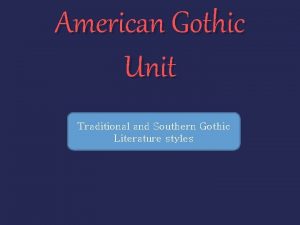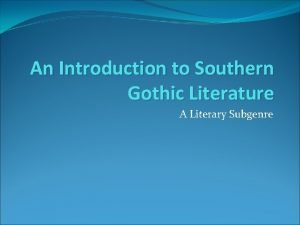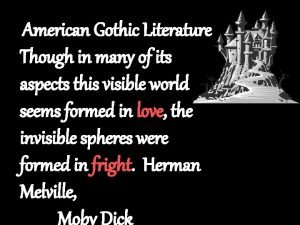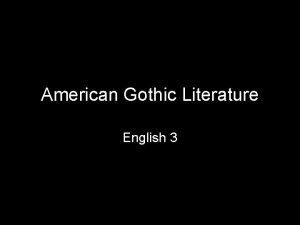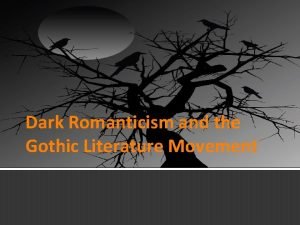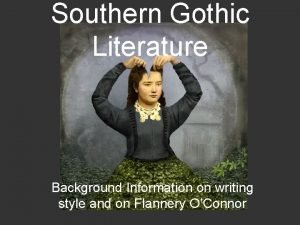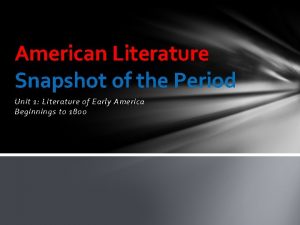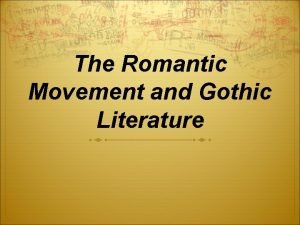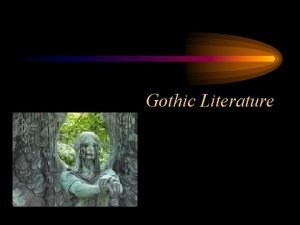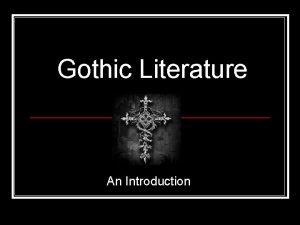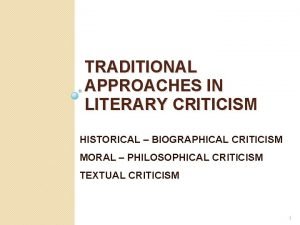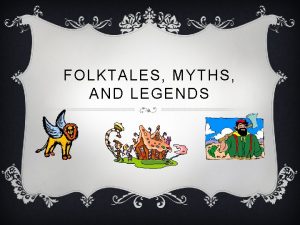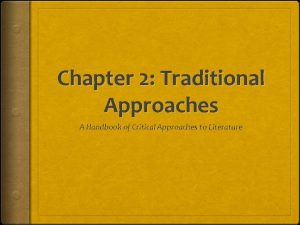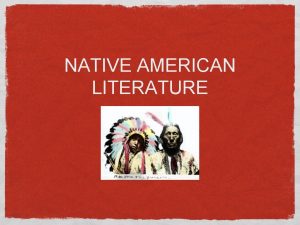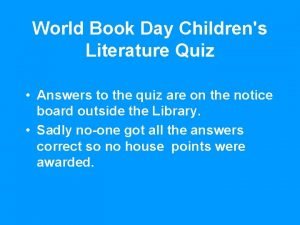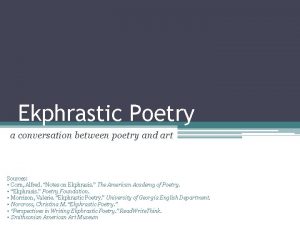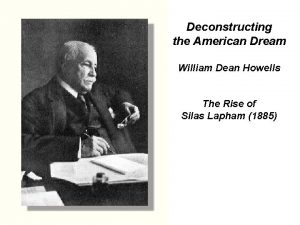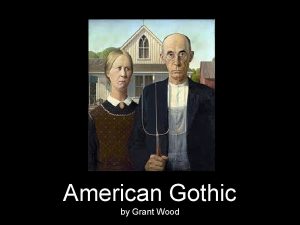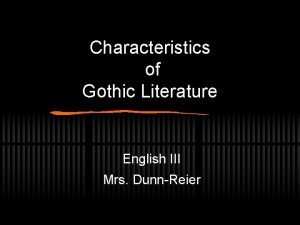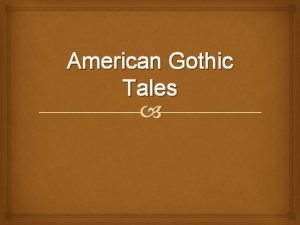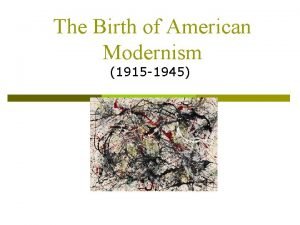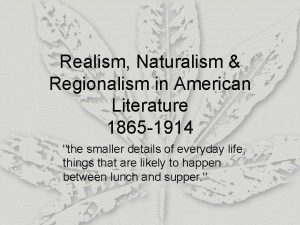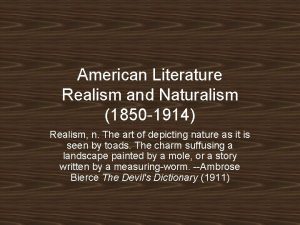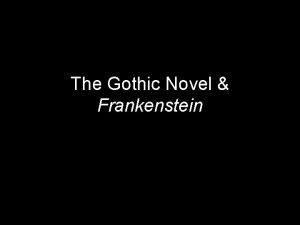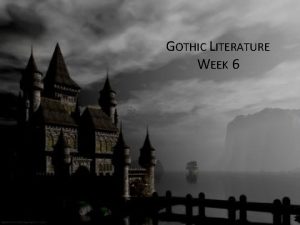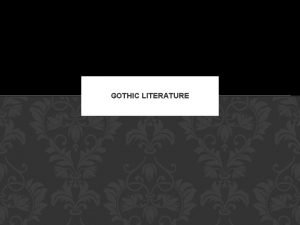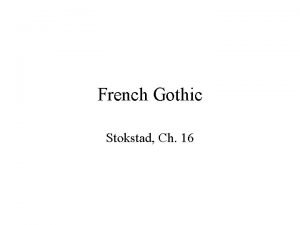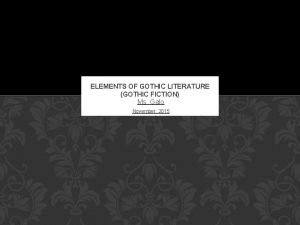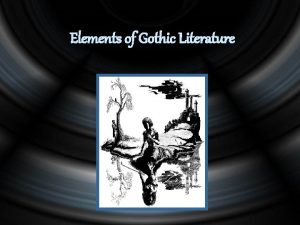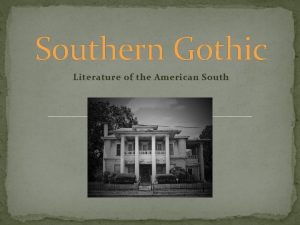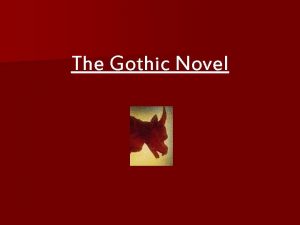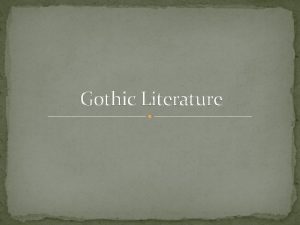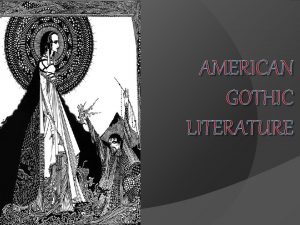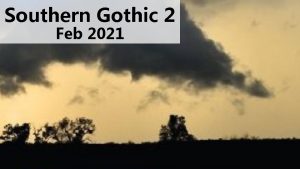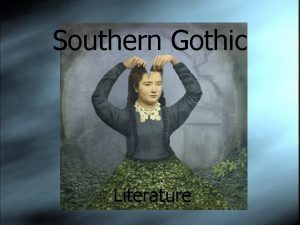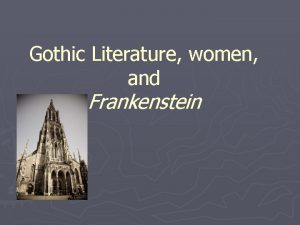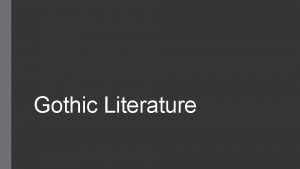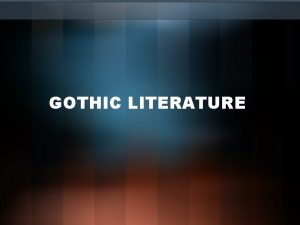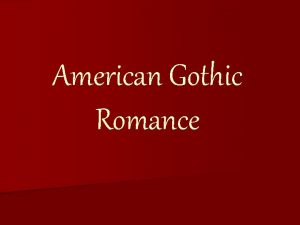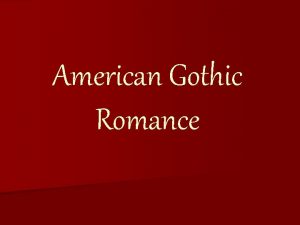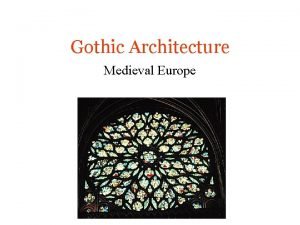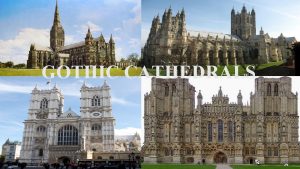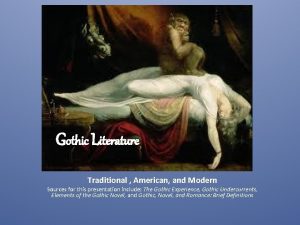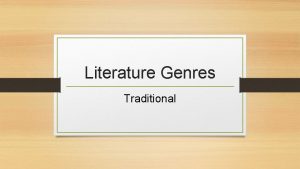American Gothic Unit Traditional and Southern Gothic Literature









































- Slides: 41

American Gothic Unit Traditional and Southern Gothic Literature styles

Traditional Gothic Characteristics:

The Nightmare • The Nightmare - Henry Fuseli • Gothic inspired painting. Wild-eyed horse. • The painting depicts a female figure lying sprawled across a divan, on her chest sits an incubus, a male demon, while in the background a wild-eyed horse may be seen. Bad Dreams. • Both creatures are artistically symbolic of the nightmare ('mare' is an Old English word for demon).

Gothic literature of the time was inspired by Gothic Architecture Gargoyle, Notre Dame Here is a typical gothic scene. Graveyard, high arched windows and a sense of gloom.

The Gothic novel "catered to the perverted taste for excitement among degenerate" and vulgar readers. The Gothic style originated in Europe centuries before it came to America. Gothic style refers to more than cathedral structures. The label applies to art, sculpture, glass works, decorative pieces and illuminated manuscripts from the mid 12 th through the early 16 th century.

Characteristics of Gothic architecture include: * The pointed arch and vault * The flying buttress (support) * Stained glass windows A gargoyle is a full-relief stone carving with an actual pipe running through it, so that rainwater will flow through it and out of a water-spout in its mouth.

Windows with diamond panes were popular. One or two bay windows were often used on the main floor, either on the front or side.

Notre Dame Brooklyn Bridge Examples of the high Gothic Arch Inside Notre Dame

Qualities of the Gothic manuscripts: • Strange monsters and fantastical creatures depicted in the margins of the page. Decorative boarders • Elaborate vine-work or leaf-work painted along the borders.

Common Gothic Motifs: Murder madness ghosts suicide lycanthropy (werewolves) doubles and doppelgangers torture vampires poltergeists

GOTHIC LITERATURE INCLUDES: • Gothic poetry, short stories, or novels were designed to thrill readers by providing mystery and blood-curdling accounts of villainy, murder, and the supernatural. Gloomy and disturbing. • The term has come to be used much more loosely to refer to gloomy or frightening literature. Many scholars believe the rise of the Gothic was a response to the prevailing mode of rational thought and reason. Enlightenment • Eighteenth century thought was dominated by an intellectual movement called the enlightenment by later historians. Enlightenment philosophers and writers valued reason and human understanding above emotions and feelings.

The rise of experimental science during this period offered an empirical model for how one could arrive at truth.

. Common Motifs of Gothic Literature • Wild and desolate landscapes • Ancient buildings such as ruined monasteries • Figures with supernatural powers • Youthful, handsome heroes and heroines who face off against corrupt aristocrats, wicked witches, and hideous monsters Gothic stories have an atmosphere of brooding gloom • cathedrals; castles with dungeons, torture chambers, secret doors, and winding stairways • apparitions, phantoms, demons, and necromancers • scientific tone (fantastic events observed empirically)

Motifs continued Damsels in distress Ancestral curses • crumbling mansions (later cities and houses) • crypts, tombs • found manuscripts or artifacts • family secrets • unnatural acts of nature (bloodred moon, sudden fierce wind, etc. ) • remote or exotic locales • dimly lit, gloomy settings • dream states or nightmares • use of traditionally "magical" numbers such as 3, 7, 13 • Specific reference to noon, midnight, twilight (the witching hours)

Gothic Novels • A type of romance wildly popular between 1760 up until the 1820 s that has influenced the ghost story and horror story of today Designed to thrill readers. • They provide mystery and blood-curdling accounts of villainy, murder, and the supernatural. • They describe the "nightmarish terrors that lie beneath the controlled and ordered surface of the conscious mind. “ Show the dark side of human nature. • Although Gothic novels were written mainly to evoke terror in their readers, they also served to show the dark side of human nature. • They show humans in extreme situations and how they react to those situations. Normally humans are kind and generous but under extreme situations, their dark, evil side emerges.

Dracula • The Gothic movement peaked during the Romantic period with such authors as Mary Shelley, Anne Radcliffe, and Nathaniel Hawthorne. • However, it survived well into the nineteenth century (as with Edgar Allen Poe). • And, in spite of some transformations, it survived into the twentieth century with Southern Gothic literature. Frankenstien

Traditional Gothic Authors

Edgar Allen Poe • Best known for his poems and short fiction, Edgar Allan Poe, born in Boston, Jan. 19, 1809, died Oct. 7, 1849 in Baltimore • He deserves more credit than any other writer for the transformation of the short story from anecdote to art. Murders in the Rue Morgue • He virtually created the detective story and perfected the psychological thriller.

Poe’s works include: • The Black Cat • Tell Tale Heart • The Raven (poem) • The Pit and the Pendulum • The Bells (poem) • Annabel Lee (poem)

Nathaniel Hawthorne • He was born on July 4, 1804 in Salem, Massachusetts, the descendent of a long line of Puritan ancestors, including John Hathorne, a presiding magistrate in the Salem witch trials. Gothic Stories • He wrote numerous short stories such as “Young Goodman Brown, ” “Rappiccini’s Daughter, ” • “Dr. Heidigger’s Experiment, ” and • “The Minister’s Black Veil. ”

Washington Irving • Irving has been called the father of the American short story. 'The Legend of Sleepy Hollow • He is best known for 'The Legend of Sleepy Hollow, ' a gothic story in which the schoolmaster Ichabold Crane meets with a headless horseman, and 'Rip Van Winkle, ' about a man who falls asleep for 20 years.

H(erbert) G(eorge)Wells • English novelist, journalist, sociologist, and historian, whose science fiction stories have been filmed many times. Wells wrote over a hundred of books, about fifty of them novels. • Wells's best known works are THE TIME MACHINE (1895), one of the first modern science fiction stories, THE INVISIBLE MAN (1897), THE MAGIC SHOP and THE WAR OF THE WORLDS (1898).

Stephen King • He is a modern day, prolific American author best known for his horror novels. • King's stories often involve an unremarkable character - middle-class families, children, and often writers - being submerged into increasingly horrifying circumstances. A clown called It. • King has written numerous works inspired by the Gothic literary movement. He’s written about vampires, zombies, and supernatural creatures.

Modern Movies, TV and Books influenced by Gothic tradition.

Southern Gothic & Modern Gothic

American Gothic Take a look at the real house that inspired Grant Wood to paint his Gothic and iconic work of art. Take a look at the gothic arch of the window and the pinched anxious expressions of the two people in the painting.

Southern Gothic Literary Style • “A lurid or macabre writing style native to the American South. Small Town Horrors • This style provides insight into the horrors in societies and “small town” social conventions. A good example would be “A Rose for Emily” by Faulkner. Grotesque Characters • Stories are set in Civil War-era mansions and contain characters who are physically or mentally grotesque. • Some gothic authors are: William Faulkner, Flannery O’Connor, Tennessee Williams

Southern Gothic • Centered on a moldering Ante Bellum mansion and featuring the lingering effects of slavery, the Civil War, or racism, actual or suggested incest or insanity. Racial Tension • These stories often contained an elderly Afro-American woman or man who is the embodiment of long-suffering goodness and wisdom. Local Color • The also included local color writing, vernacular, and a deep sense of the grotesque. • Many Southern Gothic stories contain magic realism, which thrives on the bizarre, mingling realism and fantasy.

Freakishness • You won't meet very many "normal" characters in the writings of William Faulkner, Flannery O'Connor, Truman Capote or Carson Mc. Cullers —and this is by design. Grotesque Exaggerated characters • In most southern gothic stories, there is a pivotal character or someone close to them who is set apart from the world by a disability or odd way of seeing the world.

This fascination with the outsider is in many ways used to show readers not only the individuality of the southern culture, but also to connect each reader to their own unique "freakish" nature. The Outsider

Imprisonment The idea of being locked up is often both literal and figurative in Southern Gothic works. While many southern gothic tales include an incident where a character is sent to jail or locked up, there also several gothic characters that live in fate's prison without hope of parole.

• • • Southern gothic writers covered a period in the South's history when violence was particularly prevalent. After the bloodshed of the Civil War, and the period of reconstruction that followed, racial tension and fear ran high in many small southern towns. This plays its part in many of the stories of this genre. Violence

• It wouldn't be southern gothic if you didn't feel like you'd been thrust in the center of a dusty, peach-scented, lonely downtown where porch-bound widows rock gently on creaky rockers, rusty pick-up trucks drive by filled with grimy farmhands, the general store is run by the town drunk, and flies and mosquitoes circle glasses of ice-filled lemonade. • The sense of place is strong—awash in calm, pregnant heat, lost dreams and wayward souls. Sense of Place

Southern Gothic Authors

William Faulkner • He came from an old southern family, grew up in Oxford, Mississippi. • The Southern Gothic novel Sanctuary (1931) is about the degeneration of Temple Drake, a young girl from a distinguished southern family. The Sound and the Fury (1929), the downfall of the Compson family seen through the minds of several characters.

Flannery O’Connor • Although she produced relatively few works in her short lifetime of 39 years, Mary Flannery O'Connor is considered one of the most important short story writers of the twentieth century because of her strange but interesting characters, her violent plot elements, and her religious world view. She wrote Southern Gothic stories such as “A Good Man is Hard To Find. ” • Even though her stories were grim, She sought, however, to present a message of God's grace and presence in everyday life. • O'Connor was born in Savannah, Georgia on March 25, 1925.

Shirley Jackson • Her atmospheric stories explore themes of psychological turmoil, isolation, and the inequity of fate. • She is also the author of several American Gothic novels, such as We Have Always Lived in the Castle and The Haunting of Hill House. • Shirley Jackson is the author of the classic short story, "The Lottery, " a dark, unforgettable tale of the unthinking and murderous customs of a small New England town. • She was born in San Francisco, California.

Charlotte Perkins Gilman • American writer, economist, and lecturer, an early theorist of the feminist movement, who wrote over two hundred short stories and some ten novels. The Yellow Wallpaper • Her famous gothic story, “The Yellow Wallpaper” (1892), depicted a depressed woman who slowly descends into madness in her room while her well-meaning husband is often away due to his work at a hospital.

William Gilmore Simms • Wrote the Southern Gothic poem: By the Edge of the Swamp • He wrote a wide variety of works, including poetry, plays, histories of the South, novelettes, biographies, magazine essays, medleys, and literary criticism. • Simms chose a range of settings for his romances, including colonial America, revolutionary America, and the American frontier.

The End

http: //www. oprah. com/oprahsbookclub/Southe rn-Gothic-Distinguising-Features/3 www. dunkirkcsd. org/1138207210582570/lib/. . . / southern_gothic. doc http: //www. nobelprize. org/nobel_prizes/literat ure/laureates/1949/faulkner-bio. html Works Cited
 Best american gothic novels
Best american gothic novels What is southern gothic literature
What is southern gothic literature The gothic novel characteristics
The gothic novel characteristics Gothic elements
Gothic elements American gothic definition
American gothic definition Is to kill a mockingbird southern gothic
Is to kill a mockingbird southern gothic Dark romanticism themes
Dark romanticism themes Tone in gothic literature
Tone in gothic literature Unit 1 american literature
Unit 1 american literature Patriotism and education are traditional american values
Patriotism and education are traditional american values Native american literature syllabus
Native american literature syllabus Nnnn ranch
Nnnn ranch Gothic literature englightenment
Gothic literature englightenment Gothic literature vs romanticism
Gothic literature vs romanticism Definition gothic fiction
Definition gothic fiction History of biographical criticism
History of biographical criticism Classification of children literature
Classification of children literature Characteristics of traditional literature
Characteristics of traditional literature Examples of folklore
Examples of folklore A handbook of critical approaches to literature
A handbook of critical approaches to literature Traditional literature definition
Traditional literature definition World book day quiz
World book day quiz Ekphrasis etymology
Ekphrasis etymology American gothic romanticism
American gothic romanticism Architectural style
Architectural style Marian anderson at lincoln memorial
Marian anderson at lincoln memorial American gothic style
American gothic style American gothic sculpture
American gothic sculpture Sleepy hollow gothic elements
Sleepy hollow gothic elements Modernism and experimentation in american literature
Modernism and experimentation in american literature Naturalism in literature definition
Naturalism in literature definition When was the romantic period in american literature
When was the romantic period in american literature Regionalism american literature
Regionalism american literature Foundations and encounters early american literature
Foundations and encounters early american literature Realism
Realism Unit 10, unit 10 review tests, unit 10 general test
Unit 10, unit 10 review tests, unit 10 general test Frankenstein gothic novel
Frankenstein gothic novel Gothic literature description
Gothic literature description Rhetorical terms quiz
Rhetorical terms quiz Gothic writing examples
Gothic writing examples French gothic sculpture
French gothic sculpture Metonymy gothic literature
Metonymy gothic literature
